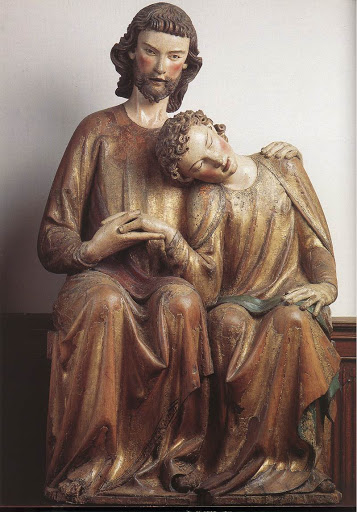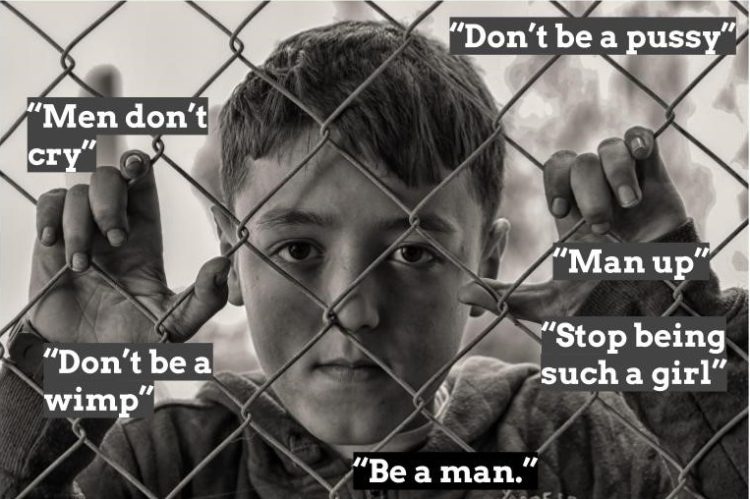Question: What do you make of the “beloved disciple” in the New Testament? Is it possible that Jesus and John had a, let us say, very “intimate” relationship? Or, to put it another way – a 30 year old unmarried guy who had a special thing for mom and hung out mostly with guys. What’s up with that?
Frank answers: Yes, Jesus had an “intimate relationship” with the “beloved disciple.” Let’s figure out what that could mean and how intimate male friendship could be expressed.
There has been a tendency among some gay interpreters to draw the conclusion that Jesus was gay and that he had something going on with the “beloved disciple,” who is usually identified as John, one of the sons of Zebedee. In fact, in some imaginations the whole group of disciples as gay. This was the case in Terrence McNally’s play, Corpus Christ, about a gay Jesus named Joshua (Jesus’ Hebrew name) who was followed across 1950s Texas by a band of gay guys. Obviously in the late 1990s this had great shock value, and still did in a 2011 revival.

Douglas Blanchard painted 24 scenes of a gay Jesus experiencing his passion, crucifixion, resurrection, and ascension, using contemporary pictorial settings. This is his painting of the last supper. The beloved disciple (in white t-shirt) leans on Jesus and Judas (in black t-shirt) tries to insinuate himself into the scene.
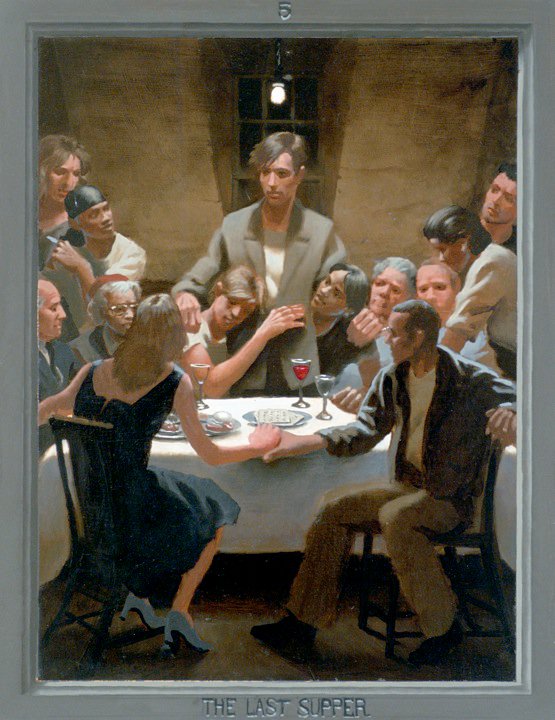
Let us recognize that there has always been a tendency to see a Jesus who is relevant to our own interests and situation. So Byzantine imperial Christianity favored the image of Christ as Pantocrator (Ruler of all things). Late medieval Western Christians, experiencing plagues and widespread death, were devoted to the crucified Jesus as the mutilated “man of sorrows.” It’s not surprising that gay Christians, who historically have been terribly persecuted by the church, would want to relate to a gay Jesus.

If Jesus was truly human, did he have sexual desires? Did he act on them? Nikos Kazantzakos imagined “the last temptation of Christ” to avoid the cross and marry Mary Magdalene. But Jesus remains celibate to the end.

What role does the “the disciple whom Jesus loved” play in the Gospels, especially in the Gospel of John where this disciple figures prominently? In a Gospel laden with symbolism commentators have looked for a symbolic role for the beloved disciple (who is never mentioned by a proper name). All icons, paintings, and carvings of Jesus and the beloved disciple show him leaning on Jesus’ breast.

The prevalence of these iconic displays of the beloved disciple resting on Jesus’ breast provided justification for same-sex male intimacy long before the contemporary search for a gay Jesus. Before the word “gay” or even “homosexual” were used to describe same-sex male relationships, those men whose sexual desires were oriented toward boys and other men pointed to this understanding of Jesus’ relationship with the beloved disciple. King James I of England (reigned 1603-1625), who was clearly homosexual, justified his sexual relationships with young men to his privy council by saying, “Jesus had his John and I have my Peter.” Figures of the Beloved Disciple resting on the breast of Jesus were common in the Middle Ages, especially in monasteries and nunneries which tried to cultivate chaste but intimate friendships. King James’ privy council would have known what their monarch was referring to.
The wood carving above this article is attributed to Heinrich of Constance c. 1480-1490. Here is another one from south Germany c. 1310.

The world’s first known depiction of the Last Supper by a woman was by Nelli, a Dominican nun and the first woman painter of Renaissance Florence. Her life-size Last Supper is about 23 feet long, almost as big as Da Vinci’s famous version. The Dominican nun was a self-taught artist with many patrons, including women. This detail shows the beloved disciple resting his head on Jesus’ chest.
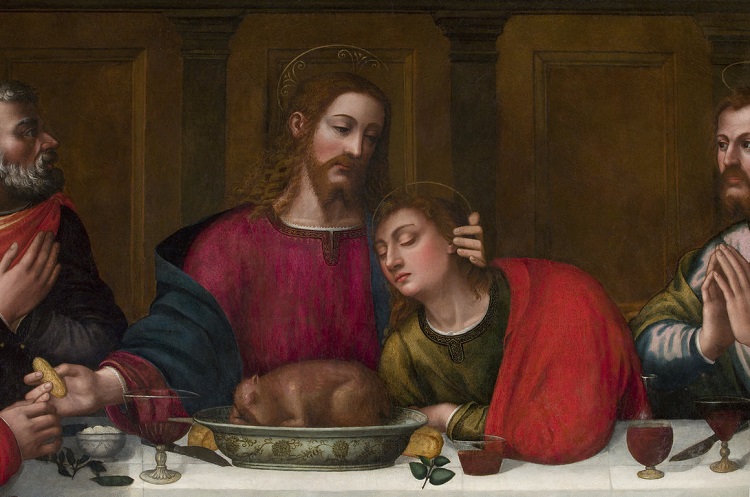
In the 1600s French painter Valentin de Boulogne presented a more emotional view of Jesus and John. The beloved disciple is laying across Jesus’ lap.

“St. John and Jesus at the Last Supper” by Valentin de Boulogne (1591–1632) (Wikimedia Commons)
However, the beloved disciple’s most prominent place in the gospel of John is at the foot of the cross with the mother of Jesus. Jesus commits the care of his mother to the beloved disciple. The very fact that Jesus would have done this indicates an intimate relationship with the beloved disciple. The scene of the three figures — Jesus on the cross, the sorrowing mother, and the beloved disciple — came to be displayed in most medieval churches as the rood scene suspended above the division between the nave and the sanctuary.
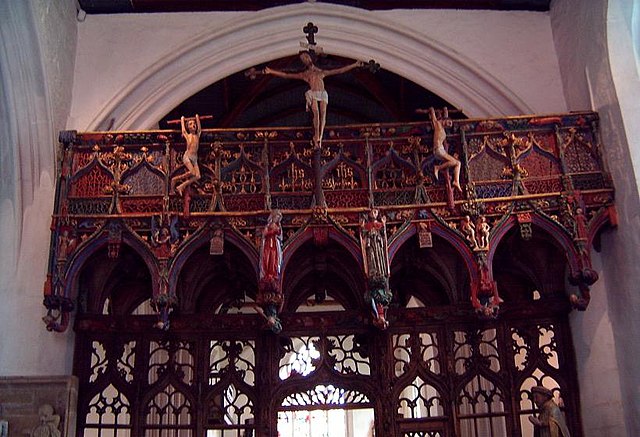
The most common symbolic interpretation of Mary in the Fourth Gospel is that she is the figure of the church. The beloved disciple is the apostle to whom the care of the church is committed.

I said in a preliminary answer to the question that Jesus had an “intimate relationship” with the beloved disciple. This can be understood in terms of a special friendship. In the Fourth Gospel Jesus says after the foot washing that he will no longer call his band “disciples” but “friends.”
“Friend” suggests a closer relationship than “disciple” or “apostle.” Eros in Greek (the basis for “erotic”) is the foundation for human connections, including friendship (philia)as well as sexual intimacy. There is no indication that Jesus had a homosexual relationship with any of his “friends,” including the “beloved disciple.” The “beloved disciple,” if it was John the son of Zebedee, was with Jesus from the beginning of his ministry, including at the wedding at Cana, as represented by Christopher Olwege in a gay scene.

In view of Jesus’ assertion that his disciples are his friends, it is surprising that there has been so much less Christian literature on friendship than on discipleship.
For the ancient Greeks, the very fabric of the city, the polis, rested on the idea of friends coming together to discuss their common interests. Plato and Aristotle included friendship as a topic for philosophic discourse. And this was male friendship.
Modern research has found that American men for the most part lack even a single male friend or buddy in whom they can confide. Michael E. McGill, The McGill Report on Male Intimacy (New York: Holt, Rinehart & Winston, 1985), characterizes male friendship as being task- or -work-related, competitive, and closed off to true intimacy apart from sexual associations.

Apart from his disciples, Jesus had another close male friend in Lazarus of Bethany, the brother of Mary and Martha. Jesus often stayed in their home. In John 11 the sisters send word to Jesus of their brother’s illness: “Lord, the man you love is ill.” Jesus waited two days before heading to Bethany. When he arrived he was greeted with the news that Lazarus had died. Each sister in turn said, “Lord, if you had been here my brother would not have died.” He asked to see the tomb. At the tomb, “Jesus wept.” “So the Jews said, ‘See how he loved him!’” In a Hellenistic context, these snippets of text within the bigger narrative would have been enough to assume a homosexual relationship. But not, I think, in the Jewish context since homosexuality had for the Jews an idolatrous context.
However, one may assume an intimate male friendship between and older and a younger man. The evangelist presents this story as the occasion for Jesus’ greatest miracle, raising Lazarus from the dead, and his greatest statement about himself, “I am the resurrection and the life.” But commentators, especially those looking for clues of a gay Jesus, have wondered about Jesus’ emotional attachment to this young man.

There is nothing in all the gospels about homosexuality or same-sex relationships. However, there is one story in which Jesus could have condemned pagan homosexual intimacy if he had wanted to: the story of the healing of the centurion’s “boy” (slave). In Matthew 8 this servant is called a pais, “boy.” In Greek usage this would have referred to a boy who was being sexually mentored by a young adult male. Pais is the root word of pederasty. In Luke 7 the servant is called a doulos, which is “slave,” and the evangelist says of this centurion’s slave that “he was dear to him.” Roman soldiers were known to keep slave boys as concubines during their long assignments away from home and often there was a loving relationship between them. Jesus must have known this, but he didn’t comment on it; he healed the boy and commended the faith of the gentile centurion.

The gay artist Christopher Olwege drew all of these intimate relationships with Jesus into the scene of Jesus’ crucifixion.
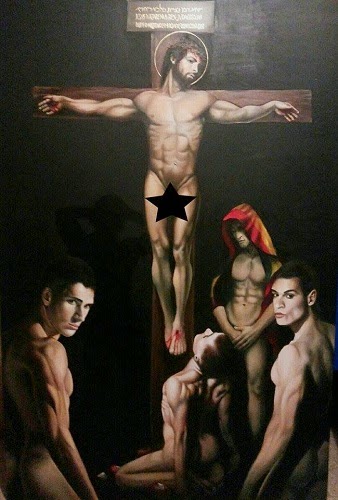
In “Crucifixion” Olwege shows a group of men reacting in various ways to Jesus on the cross. John the Beloved Disciple is kneeling at the foot of the cross with his head thrown back, expressing deep emotion. Jesus’ friend Lazarus, whom he raised from the dead, bows his head in sorrowful prayer beneath a rainbow hood. The Centurion on the left and the youth “who was dear to him” on the right, whom Jesus willingly healed at the Centurion’s request, frame the scene. Here is a photo of the artist, who was Mr. Gay World 2013, working on this painting.

Male-on-male sex (especially between older boys and men) was ubiquitous in the ancient Greco-Roman world. Those men who had sex with youth or other men were not exclusively homosexual. They were usually married and the father of children. We have to ask to what extent this kind of male-on-male sex was practiced among the ancient Israelites or the Jews of Jesus’ time. There’s no doubt that sodomy was practiced because cult prostitution (especially male) was condemned as an “abomination” In Leviticus 18:22. The issue was spilling Israel’s seed in the service of a false god. The Lord repeatedly said he was “a jealous God.” Was this abomination a blanket condemnation of all male-on-male sex or only in sacred prostitution?
There is a biblical friendship that does suggest, if not a homosexual at least a homoerotic, relationship: the friendship of David and Jonathan. After the shepherd boy David’s killing of the Philistine Goliath and bringing the giant’s severed head to King Saul, the king’s son Jonathan (also a warrior) was smitten by the good looking hero. The biblical text says that “the soul of Jonathan was bound to the soul of David, and Jonathan loved him as his own soul” (1 Samuel 18:1). Jonathan made a lifelong covenant with David by stripping himself of the robe he was wearing and giving it to David.
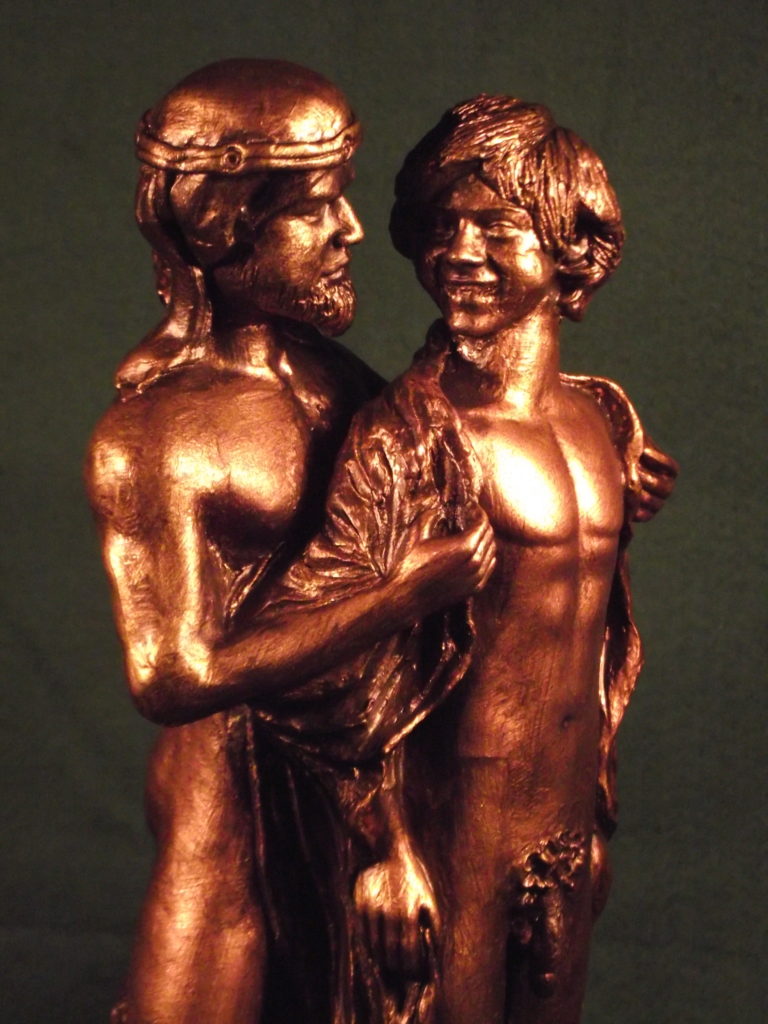
David stayed in Saul’s house and was given the king’s daughter Michal in marriage. David soothed Saul’s troubled spirit by playing the harp for him and he was also victorious in battles against the Philistines. Time and again in a jealous rage Saul tried to kill David and Jonathan always interceded for him. Finally he helped David escape from Saul’s court, but not without kissing and shedding many tears (1 Samuel 20:41). David lived as an outlaw for a time and finally took refuge in the land of the Philistines while Saul continued to wage war on the Philistines. When news of Saul’s and Jonathan’s deaths in battle was brought to David, he lamented greatly. “I am distressed for you, my brother Jonathan; greatly beloved were you to me; your love to me was wonderful, passing the love of women” (2 Samuel 1:26).
David compared his love for Jonathan to heterosexual love, saying it even surpassed it. Jonathan had pursued David from the beginning and provided his covenanted partner with protection from his mentally deranged father. Considering the extent of homosexual relationships between men in the ancient Middle East, even between warriors, it is likely that David and Jonathan had an intimate friendship that involved homoerotic feelings, if not behavior.
The love triangle between David, Jonathan — and Jonathan’s father Saul — sprang to life in the 2020 queer Bible musical Beloved King, which brings out all the homoerotic nuances in biblical story with a faithful adaptation and emotional intensity that stirs both heart and soul. The passionate gay love saga of plays against a dizzying backdrop of war and witches.

Beloved King was written by Jade Sylvan as one of the requirements for a master of divinity degree at Harvard Divinity School. Sylvan has won awards for writing in various media, including the New England Book Award for the 2013 novelized memoir Kissing Oscar Wilde. The first run of Beloved King performances was sold out for March 2020 at Oberon Theater in Harvard Square, Cambridge. But the night before opening it had to be postponed indefinitely due to the surge in the COVID-19 pandemic. During the shutdown Sylvan occasionally made the final dress-rehearsal video available through live-stream viewing parties.

David was obviously not exclusively homosexual, as his sultry seduction of Bathsheba demonstrates. But the story of David and Jonathan illustrates the ambiguity in intimate male friendship between homoerotic feelings and homosexual expressions of love.

Today “intimacy” is understood primarily in a sexual context and male intimacy is assumed to be homosexual. The problem is that the modern clinical designations “homosexual” and “heterosexual” define the entire being of a person according to a particular sexual orientation. Before the use of these clinical terms became widespread in the late 19th century individuals weren’t understood in terms of an orientation but only in terms of their sexual behavior — sexual acts that could be performed by either homosexuals or heterosexuals such as oral and anal sex.
In traditional societies of indigenous people homosexual behavior was accepted and sometimes encouraged. In Western heterosexual-exclusive societies homosexual behavior was not only discouraged but severely punished by law, including death by burning. But it was the act that was the crime, not the being of the person. Homophobia is a consequence of heterosexual cultural exclusivity combined with this clinical designation of same-sex attraction. It’s the fear of contact with men whose very being implies a same-sex attraction. “Straight” men don’t want to get too close, maybe for fear of a “come on” or because they don’t want to be perceived as gay. As a consequence they suppress their own homoerotic feelings.

What has been lost is a more fluid sexual relationship between men that allows for expressions of non-sexual male intimacy. Being present to a male friend going through a personal trauma by giving physical comfort– hugging, cuddling, even kissing — should not be considered “gay.” It’s what men should be capable of doing, whether gay or straight or somewhere in between.

Boys and men have hugged and kissed each other and even slept together when necessity required it. For example, in the crowded hotels and boarding houses on the American frontier men often shared a bed. Abraham Lincoln shared a bed with Joshua Speed and several other men in his life, including the captain of the guard detailed to protect the President. Some of his biographers have probed Lincoln’s ambiguous sexuality, but the social convention at that time is not enough by itself to regard Lincoln as a homosexual. Sharing your bed with a visiting friend from out-of-town, or having a sleepover with a school mate, does not imply a homosexual relationship.
George Washington’s relationship with young officers under his command during the Revolutionary War has also been studied. His letters indicate a more relaxed relationship with them than the stolid Washington usually communicated. He had a particular fondness for the 20-year old Marquis de Layafette, whom he made a general and who distinguished himself at the Battle of Yorktown. Sleeping outside on the battle field one cold night Washington wrapped the Marquis against his own body under his great coat. It may be more fitting to see Washington’s relationship with the young Frenchman like a father-son bond with a son he never had.
A British study released in March 2029 in the journal Men and Masculinities reported that 98 percent of the heterosexual men interviewed had shared a bed with another guy, and 93 percent of them had cuddled or spooned with one. The study was conducted by two researchers at Winchester and Durham Universities, sociologists Eric Anderson and Mark McCormick, who questioned 40 university athletes and reported that “in addition to cuddling, participants also engage in ‘spooning’ with their heterosexual male friends.”
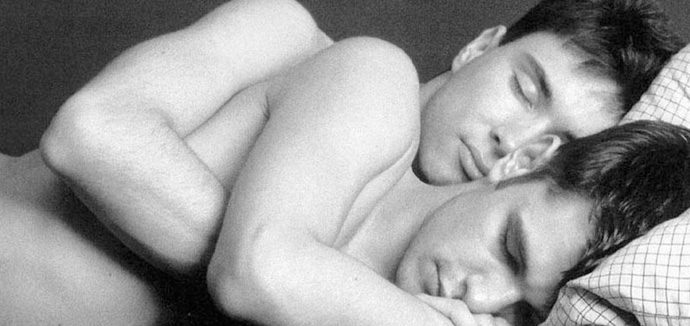
This kind of research has its flaws. First, the sample is pretty narrow. It was self-selected among young university athletes who volunteered. Athletes are used to being around other male bodies, even being naked in locker rooms and showers, huddling and hugging one another on the sports field. Secondly, the participants self-reported so the researchers had to take their word for it. How much this reflects the general population of young men is hard to say. But it does suggest that a lot of young men, probably here in North America as well as well as in the British Isles, have occasionally hugged, cuddled, and even slept with another male — even naked.

This suggests that cuddling is not necessarily a gay thing, although gay men undoubtedly engage in it a lot. The emergence of “cuddle clubs” in the last several years that include both heterosexual and homosexual middle age men indicates that men need cuddling, just as women do. But even through male cuddling is a same-sex activity, what difference does it make? Why should gay men have all the benefits of intimate male bonding? Cuddling with a man isn’t going to make you gay if you don’t identify as gay and aren’t exclusively same-sex in your orientation.
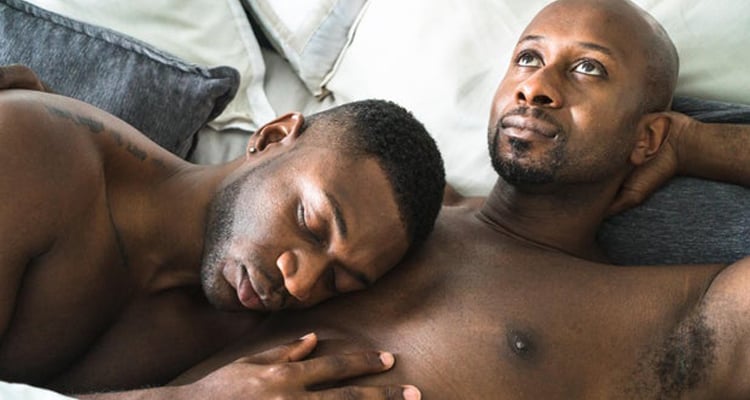
Many of us had these kinds of experiences when we were boys. I had situations of sharing a bed with my younger brother or a buddy or with a room mate on a summer work crew or choir tour. We didn’t wear pajamas; that was uncool. And, yes, sometimes we cuddled during the night. It wasn’t a sexual thing. It was just the human need for touch and bonding.
In fact, there is an issue about male friendship and intimacy that is present in all of these relationships — Jesus and the beloved disciple, Jesus and Lazarus, Jonathan and David, Washington and Lafayette. There was an age disparity between the two men. Jesus was older than John or Lazarus, Jonathan was older than David, Washington was older than Lafayette. Older and younger men need each other. The older man bestows wisdom on the younger man; the younger man bestows creativity on the older man. This used to happen in rites of initiation in traditional societies, which modern secular society lacks. Older men provided knowledge for the young; younger men provided vitality for the tribe.
We may say that Jesus was able to practice an intimate friendship with young men who desired his wisdom and were rewarded with his love in the case of Lazarus and “the disciple whom Jesus loved.” Boys and young men have looked to older men for wisdom and affirmation. They may have sought and found it in their father, a teacher, a sports coach, even a priest or pastor. They may have desired a more intimate relation with these mentors. Some mentors have crossed the line and taken sexual advantage of the young men they were mentoring. Others have restrained themselves while not failing to provide the guidance these young men needed.

Sometimes boys and young men have allowed their intimate friendships to result in homoerotic intimacy expressed in touching and exploring the other’s body, which may be received and reciprocated. The famous (or infamous) Kinsey Report found that the 20,000 subjects interviewed in the study of male sexuality had varying degrees of both heterosexual and homosexual experiences. It concluded that “males do not represent two discrete populations, heterosexual and homosexual.” The Kinsey Institute proposed a continuum in male responsiveness to erotic behavior.
Ritch C. Savin-Williams has published his study of millennial men entitled Mostly Straight: Sexual Fluidity Among Men (Harvard University Press, 2017) that shows the willingness of “straight” young men to have gay sex when the occasion and opportunity presents itself. The book includes interviews with several of Savin-Williams’ subjects.

This being said, we must also recognize that many men have had problems with the erotic. They see it confined to sexual activity in the bedroom. They have kept their passions, their desire to touch or to hug another male, under control. Letting loose with homoerotic feelings in other areas of their lives, even with their best friend, seems unmanly. And straight men don’t want to be perceived as gay. There’s a stigma attached to it. But eros invites men to loosen their grip on their need to control and be able to express their feelings and needs and even their love toward another man.
Putting people in boxes — gay, straight, bisexual — doesn’t do justice to sexual fluidity. But it also needs to be said that eros is not just about sex. Nor is male intimacy in friendship about sex. Men can have, and need, close friendships with other men.

But that doesn’t mean that male intimacy avoids physical contact. Recent research by the Kinsey Institute found that men like cuddling and need touch as much if not more than women. Male cuddling social groups have been formed that include gay and straight men. Men cuddling men is not necessarily a gay thing. There’s also no reason that gay and straight men can’t be buddies to each other and share intimate thoughts and feelings and sometimes express that intimacy in physical touch. Male intimacy has been so spiritualized that it has lost all connection with the body.
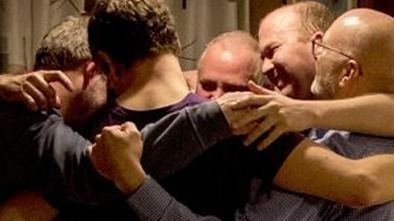
Jesus himself made no pronouncement about homosexuality because the concept wasn’t available at the time. Nor did he hang out mostly with men. A rabbi having male disciples was conventional. The unconventional thing about Jesus is that he also had women disciples who followed him from Galilee to Jerusalem.
Jesus had a lot to teach us about love for one another, including the intimacy of friendship. One of his friends was “the disciple whom Jesus loved,” whom Jesus allowed to lay on his breast during the last supper with his disciples. Jesus showed no sign of being turned off by this bodily display of affection. The love that Jesus had for his “friends,” as he called them at the supper in the upper room, was not lacking in physical display. He allowed bodily expressions of emotional intimacy as he took off his outer garments, knelt down, and washed their feet.
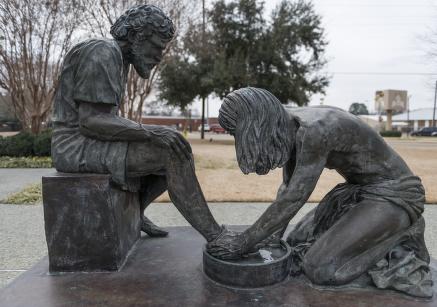
Jesus washing Peter’s feet in Witness Park outside the “Prayer Tower,” perhaps the most recognizable landmark in Pittsburg, Texas
Women have much less difficulty with intimate friendship than men do. Many women have such friends with whom they can share their life issues. I believe that men also need an intimate friend, a buddy who can be relied upon just to be a companion — someone beyond spouse and family and work associates, maybe even a gay friend. I think gay men also need a friend, perhaps even a straight friend, beyond their gay friends and lovers.
Men, whether gay or straight, need buddies who can be “sounding boards” as they navigate their relationship with the significant woman in their life — or with a significant man. Among such friends it’s not so strange today to find expressions of intimacy in hugging and kissing. (I’ve been kissed by gay and straight men.)

Among ancient Celtic Christians, especially in monasteries, it was considered important for both men and women to have a soul friend in whom they entrusted the secrets of their lives. This often resulted in erotic behavior, including physical touching. Often this eros was expressed in nipple sucking. References to children and young men being suckled by older male saints can be found in Lives of the Irish Saints. Interestingly, they compared this to the beloved disciple cuddling on the breast of Jesus. John is said to have “sucked the fountain of true wisdom from the breast of the Savior.”

The third century friends and martyrs, Saints Bacchus and Sergius, who are believed to have been in a homoerotic if not homosexual relationship, have been portrayed in an intimate embrace, including this painting of them engaged in nipple sucking by gay artist Rick Herold.

Today this practice would fall into the category of a fetish. like kissing feet, which was also a regular ancient practice. Nipple sucking is not uncommon among gay men as part of foreplay before sex. But I’ve also read about straight men engaging in this practice as buddies. Something being a fetish doesn’t mean that it’s sinful; it means it’s socially deviant.
We also need to ask whether married men can or should have a male soul friend. In many ancient societies, especially in ancient Greece, male mentoring of young men that included homoerotic activity was practiced by married men. We don’t know what their wives thought of this. Male relationships of this sort was also practiced in the ancient Celtic societies. It seems the wives were not always pleased that their husbands would rather sleep on the floor with other men like their hunting buddies. Today we have the new wrinkle of married gay men. What do their husbands think of their spouses having an intimate male friendship outside of their marriage? What restraints does marriage place on intimate friendship with another person?
Obviously, these are issues that marriage couples need to work out. It’s not just sex outside of marriage that is the issue, but intimacy that involves sharing of thoughts and feelings. I would note, however, that even in our heterosexual-dominant society, some men continue to have friendships with buddies from their youth, sports buddies, former military buddies (the bonds between military men have always been strong).
Men, whether gay or straight, need an intimate male friendship with someone — a soul friend — , whether straight or gay, with whom he can communicate openly and honestly, with warmth and affection — someone who is trustworthy and caring. Most men don’t receive this affection from their fathers, who probably didn’t receive it from their fathers. That’s why we need friends, and often look for older friends who can also providing the mentoring we need. But older men are revitalized mentally and even physically by mentoring younger men. Blessed are you, young man, if you have such an intimate friend. Blessed are you, old man, if you have such an intimate friend.

Finally, we all need to ask what it means for us that Jesus calls us “friends.” When I was a youngster in Sunday School, and some times in the church service, we used to sing the hymn “What a friend I have in Jesus.” What does this friendship mean and how is it expressed? Certainly the Beloved Disciple in the Fourth Gospel shows an intimacy between men by resting his head on Jesus’ breast. This can be taken symbolically to indicate listening or entering into the heart of a friend. It is an expression of bonding between men and even between humans and God. But it is expressed by physical contact. (I have loved this photo of two men of different races cuddling each other.)

The gay artist Ric Stott has produced paintings inspired by the writings of St. John of the Cross, who led a life of struggle for reform of the church in late 16th century Spain and endured personal suffering because of it, including imprisonment and flogging by church church authorities. He embraced Christ in his battered body.
The gay artist Ric Stott wrote, “The faith of Christ that I experience isn’t about separating myself off into some pristine spiritual sanctuary and escaping into a fantasy world. It is about bodies fully engaged together and giving oneself wholly to the other so as to become ‘utterly real.'”
Jesus said to his disciples in the upper room, “On that day you will realize that I am in my Father, and you are in me, and I am in you” (John 14:20). To which I say “Amen.
Pastor Frank


